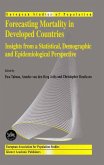Information on future mortality trends is essential for population forecasts, public health policy, actuarial studies, and many other purposes. Realising the importance of such needs, this volume contains contributions to the theory and practice of forecasting mortality in the relatively favourable circumstances in developed countries of Western Europe.
In this context techniques from mathematical statistics and econometrics can provide useful descriptions of past mortality. The naive forecast obtained by extrapolating a fitted model may give as good a forecast as any but forecasting by extrapolation requires careful justification since it assumes the prolongation of historical conditions. On the other hand, whilst it is generally accepted that scientific and other advances will continue to impact on mortality, perhaps dramatically so, it is impossible to quantify more than the outline of future consequences with a strong degree of confidence. The decision to modify an extrapolation of a model fitted to historical data (or conversely choosing not to modify it) in order to obtain a forecast is therefore strongly influenced by subjective and judgmental elements, with the quality of the latter dependent on demographic, epidemiological and indeed perhaps more general considerations. The thread running through the book reflects therefore the necessity of integrating demographic, epidemiological, and statistical factors to obtain an improvement in the prediction of mortality.
In this context techniques from mathematical statistics and econometrics can provide useful descriptions of past mortality. The naive forecast obtained by extrapolating a fitted model may give as good a forecast as any but forecasting by extrapolation requires careful justification since it assumes the prolongation of historical conditions. On the other hand, whilst it is generally accepted that scientific and other advances will continue to impact on mortality, perhaps dramatically so, it is impossible to quantify more than the outline of future consequences with a strong degree of confidence. The decision to modify an extrapolation of a model fitted to historical data (or conversely choosing not to modify it) in order to obtain a forecast is therefore strongly influenced by subjective and judgmental elements, with the quality of the latter dependent on demographic, epidemiological and indeed perhaps more general considerations. The thread running through the book reflects therefore the necessity of integrating demographic, epidemiological, and statistical factors to obtain an improvement in the prediction of mortality.








